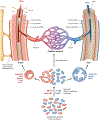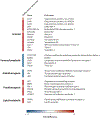Arterial Venous Differentiation for Vascular Bioengineering
- PMID: 29641908
- PMCID: PMC9235071
- DOI: 10.1146/annurev-bioeng-062117-121231
Arterial Venous Differentiation for Vascular Bioengineering
Abstract
The development processes of arteries and veins are fundamentally different, leading to distinct differences in anatomy, structure, and function as well as molecular profiles. Understanding the complex interaction between genetic and epigenetic pathways, as well as extracellular and biomechanical signals that orchestrate arterial venous differentiation, is not only critical for the understanding of vascular diseases of arteries and veins but also valuable for vascular tissue engineering strategies. Recent research has suggested that certain transcriptional factors not only control arterial venous differentiation during development but also play a critical role in adult vessel function and disease processes. This review summarizes the signaling pathways and critical transcription factors that are important for arterial versus venous specification. We focus on those signals that have a direct relation to the structure and function of arteries and veins, and have implications for vascular disease processes and tissue engineering applications.
Keywords: arterial venous endothelial cells; stem cell differentiation; vascular bioengineering; vascular development.
Figures




References
-
- Wang HU, Chen ZF, Anderson DJ. 1998. Molecular distinction and angiogenic interaction between embryonic arteries and veins revealed by ephrin-B2 and its receptor Eph-B4. Cell 93:741–53 - PubMed
-
- Jones EA. 2011. The initiation of blood flow and flow induced events in early vascular development. Semin. Cell Dev. Biol 22:1028–35 - PubMed
-
- Shin D, Garcia-Cardena G, Hayashi S, Gerety S, Asahara T, et al. 2001. Expression of ephrinB2 identifies a stable genetic difference between arterial and venous vascular smooth muscle as well as endothelial cells, and marks subsets of microvessels at sites of adult neovascularization. Dev. Biol 230:139–50 - PubMed
-
- Herzog Y, Guttmann-Raviv N, Neufeld G. 2005. Segregation of arterial and venous markers in subpopulations of blood islands before vessel formation. Dev. Dyn 232:1047–55 - PubMed
-
- Zhong TP, Childs S, Leu JP, Fishman MC. 2001. Gridlock signalling pathway fashions the first embryonic artery. Nature 414:216–20 - PubMed
Publication types
MeSH terms
Substances
Grants and funding
LinkOut - more resources
Full Text Sources
Other Literature Sources

